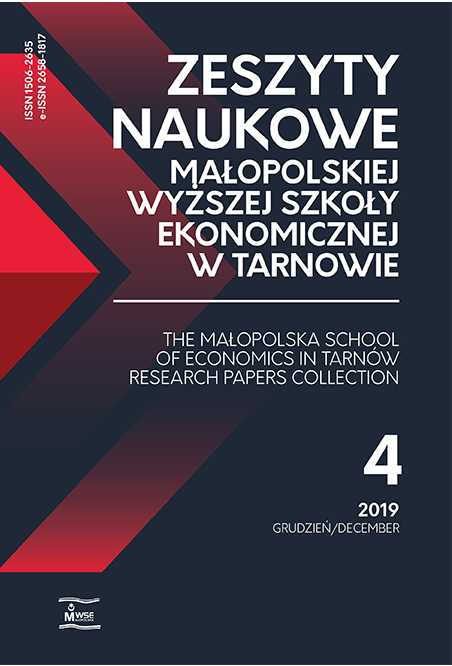Abstract
This article deals with the issue of linking remuneration with the effectiveness of business operations. The aim of the study was to determine the strength and direction of the relation between remuneration and the effectiveness of economic activity, taking into account its various measures as well as sectorial and sectional division of the Polish economy. For this purpose, data from the Central Statistical Office for the years 2005–2017 was used for values classified as total, public and private sector in addition to PKD (Polish Classification of Activities) sections. To determine the relations in the study, Pearson’s correlation coefficient was used, which was estimated for the relation of remuneration between work efficiency (based on revenues from total activity and net financial result) and profitability (assets, equity, revenues from total activity). Three of the four hypotheses were verified as negative. First, the remuneration was not always related to the effectiveness of business operations. Secondly, the increase in the efficiency of business operations was not always accompanied by an increase in wages. Thirdly, the salary was not always the strongest link to labour productivity. The only positively verified hypothesis was the one which assumed sectorial and sectional differentiation of the relation between remuneration and individual measures of effectiveness of business activity.
References
Adamczyk, P. (2007). Wydajność pracy a poziom wynagrodzeń osób zatrudnionych w przemyśle mięsnym. Zeszyty Naukowe Szkoły Głównej Gospodarstwa Wiejskiego. Ekonomika i Organizacja Gospodarki Żywnościowej, 62, 55–65.
View in Google Scholar
Armstrong, M. (2005). A handbook of employee reward management and practice. 2nd ed. Logan: Kogan Page Publishers. ISBN 074944343X.
View in Google Scholar
Blanchflower, D. G. (1991). The economic effects of profit sharing in Great Britain. International Journal of Manpower, 12(1), 3–9. DOI 10.1108/01437729110135501.
View in Google Scholar
Bun, M. J., Huberts, L. C. (2018). The impact of higher fixed pay and lower bonuses on productivity. Journal of Labour Research, 39, 1–21. DOI: 10.1007/s12122-017-9260-9.
View in Google Scholar
Datta, D. K., Guthrie, J. P., Wright, P. M. (2005). Human resource management and labour productivity: Does industry matter? Academy of Management Journal, 48(1). DOI 10.5465/amj.2005.15993158.
View in Google Scholar
Fibírová, J., Petera, P. (2013). Profit-sharing―A tool for improving productivity, profitability and competitiveness of firms? Journal of Competitiveness, 5(4), 3–25, DOI: 10.7441/joc.2013.04.01.
View in Google Scholar
Folwarski, M. (2017). Dysproporcje w wynagradzaniu pracowników w bankach prowadzących działalność w Polsce. Prace Naukowe Uniwersytetu Ekonomicznego we Wrocławiu. Ekonomia, 489, 105–114. DOI: 10.15611/pn.2017.489.09.
View in Google Scholar
Gielen, A. (2007). Performance pay, training and labor mobility. IZA Discussion Paper, no. 2932. Bonn: Institute for the Study of Labor (IZA).
View in Google Scholar
Gogtay, N. J., Thatte, U. M. (2017). Principles of correlation analysis. Journal of the Association of Physicians of India, 65(3), 78–81.
View in Google Scholar
Golnau, W. (2012). The efficiency wage theory. Journal of Management and Finance, 10(2, part 1), 151–159.
View in Google Scholar
Hamermesh, D. S. (2014). Do labour costs affect companies’ demand for labour? IZA World of Labor. DOI: 10.15185/izawol.3.
View in Google Scholar
Katovich, E. S., Maia, A. G. (2018). The relation between labour productivity and wages in Brazil: A sectorial analysis. Nova Economia, 28(1), 7–38. DOI: 10.1590/0103-6351/3943.
View in Google Scholar
Kawka, T. (2016). Analiza zarządzania wynagrodzeniami w organizacjach nowej gospodarki w Polsce. Prace Naukowe Uniwersytetu Ekonomicznego we Wrocławiu, 429, 77–90. DOI: 10.15611/pn.2016.429.08.
View in Google Scholar
Kopycińska, D., Wiśniewski, R. (2016). Systemy motywacyjne członków zarządów spółek giełdowych w Polsce: studium przypadku. Studia i Prace WNEiZ US, 44(2), 167–190. DOI: 10.18276/sip.2016.44/2-13.
View in Google Scholar
Kruk, S. (2017). Rentowność jako kryterium oceny efektywności gospodarowania przedsiębiorstwa. Finanse, Rynki Finansowe, Ubezpieczenia, 89(5), 217–225. DOI: 10.18276/frfu.2017.89/1-17.
View in Google Scholar
Lazear, E. P. (2000). Performance pay and productivity. American Economic Review, 90(5), 1346–1361. DOI: 10.1257/aer.90.5.1346.
View in Google Scholar
Madhani, P. M. (2011). Realigning fixed and variable pay: Compensation management. SCMS Journal of Indian Management, 8(1), 5–17.
View in Google Scholar
Mukaka, M. M. (2012). A guide to appropriate use of correlation coefficient in medical research. Malawi Medical Journal, 24(3), 69–71.
View in Google Scholar
Nyk, M. (2016). Płaca wydajnościowa w modelu Shapiro-Stiglitza – ujęcie regionalne. Studia i Prace WNEiZ US, 44(3), 175–188. DOI: 10.18276/sip.2016.44/3-14.
View in Google Scholar
Oleksiak, P. (2013). Dysfunkcje systemu wynagradzania w organizacji. Acta Universitatis Lodziensis. Folia Oeconomica, 288, 131–141.
View in Google Scholar
Pinto, E. P. (2011). The influence of wage on motivation and satisfaction. The International Business & Economics Research Journal, 10(9), 81–91.
View in Google Scholar
Rynes, S. L., Gerhart, B., Minette, K. A. (2004). The importance of pay in employee motivation: Discrepancies between what people say and what they do. Human Resource Management, 43(4), 381–394. DOI: 10.1002/hrm.20031.
View in Google Scholar
Samuel, M., Okey, L. E. (2015). The relevance and significance of correlation in social science research. International Journal of Sociology and Anthropology Research, 1(3), 22–28.
View in Google Scholar
Statistical Yearbook of the Republic of Poland. (2006–2018). Warsaw: Statistic Poland.
View in Google Scholar
Syverson, C. (2011). What determines productivity? Journal of Economic Literature, 49(2), 326–365. DOI: 10.1257/jel.49.2.326.
View in Google Scholar
Velnampy, T. (2011). Value added, productivity and performance of few selected companies in Sri Lanka. Indian Journal of Commerce and Management Studies, 2(6), 49–55.
View in Google Scholar
Watters, P. A., Boslaugh, S. (2008). Statistics in a nutshell. Navi Mumbai: Shroff Publishers. ISBN 9352134621.
View in Google Scholar
Ważna, L. (2012). Teoretyczne i praktyczne aspekty wykorzystania wybranych instrumentów controllingu. Prace Naukowe Uniwersytetu Ekonomicznego we Wrocławiu, 251, 526–538.
View in Google Scholar
Zabolotnyy, S. (2009). Sytuacja finansowa spółek giełdowych z wybranych branż produkcyjnych. Zeszyty Naukowe SGGW w Warszawie. Ekonomika i Organizacja Gospodarki Żywnościowej, 76, 121–133.
View in Google Scholar
© Copyright by Małopolska School of Economics in Tarnów. The articles are available under the Creative Commons Attribution NonCommercial-NoDerivatives 4.0 International License


